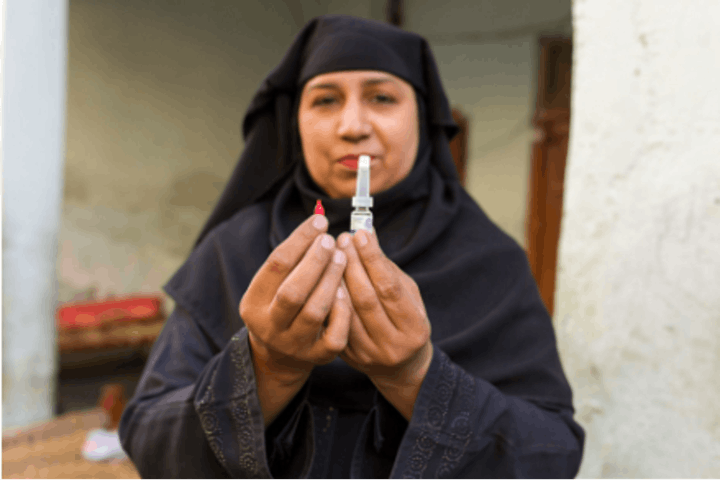Last updated July 25, 2023
Written by: Elizabeth Thrush, Senior Polio & Immunization Advocacy Officer, United Nations Foundation
The fight against polio is at a critical juncture as the Global Polio Eradication Initiative (GPEI) aims to eliminate all polio cases by the end of 2023. With only 6.5 months left in the year, the Independent Monitoring Board (IMB) met with officials from polio-affected countries and key stakeholders in mid-July to assess progress, identify hurdles, and provide recommended actions to meet the program’s goals:
In the weeks following the meeting, the members of this independent body will critically evaluate these updates and formulate their assessment and recommendations for corrective actions that need to be taken in order to achieve the ultimate goal of zero polio cases. The report outlining their recommendations will be available in September alongside the other IMB reports here.
Below is a summary of the key progress points and the most challenging obstacles faced for eradication efforts.

Significant progress has been made in reducing wild poliovirus type 1 (WPV1) transmission in Pakistan and Afghanistan, the two countries where the virus is still endemic. As of July 2023, only one case has been reported in Pakistan and five in Afghanistan. Environmental surveillance indicates that transmission has slowed, with positive samples declining from 8% in 2021 to 1% in 2023. Genetic analysis shows that the virus is now more localized, with fewer instances of “genetic clusters,” suggesting reduced movement.
Despite these encouragingly low numbers, the fact that we are still seeing some cases proves that the poliovirus survived the “low season.” Typically, winter and early spring in the northern hemisphere (December through May) is considered “low-transmission season” for the poliovirus. Peak transmission has historically occurred during the late summer and autumn. Therefore, these next few months will be crucial to reach every last child with the polio vaccine and ensure a polio-free world.
To do this, there are quite a few hurdles the program will need to be overcome. Healthcare workers continue to face challenges in getting the vaccine to all children, especially in high-risk areas. Some of these challenges are due to political instability, security concerns, vaccine refusals, and inconsistent campaign quality. To combat these hurdles, efforts are underway to change vaccine perceptions among populations that have been refusing vaccination in Pakistan. Strategies such as ring-fencing are being used to target inaccessible children in the Mehsud Belt of Pakistan. This involves increasing immunity coverage in surrounding areas and vaccinating all travelers crossing borders.
In Afghanistan, special effort needs to be made to reach older children who may have missed vaccination when they were younger due to previous periods of inaccessibility. These older unvaccinated children create pockets of susceptibility for the virus to survive. Finally, the high levels of population movements within Afghanistan and across the border with Pakistan mean that both countries will need to remain highly vigilant to ensure that the virus does not continue to spread.
With all this in mind, finishing wild poliovirus this year looks feasible, but only if these hurdles can be overcome.

Over the last year, there has been an increase in polio outbreaks outside of the endemic countries. Most of these outbreaks are a type of polio called “vaccine-derived poliovirus” or VDPV. This virus has been seen in several countries (including in environmental surveillance in the United States, Israel, and the UK). Despite having a different name, both VDPV cases and WPV cases cause the same disease, poliomyelitis, and the same debilitating outcomes for children and parents. To reach a polio-free world, it is equally important to stop these outbreaks as it is to end the wild poliovirus.
While progress has been made in some areas to control these outbreaks, there have been many challenges in specific geographic regions. Analysis of transmission patterns shows that four specific sub-national areas are driving the continued spread: eastern Democratic Republic of the Congo, northern Nigeria, central Somalia, and North Yemen. These geographies account for over 84% of global VDPV cases since January 2022. Response efforts in these countries are hindered by evolving security and humanitarian crises. To stop these outbreaks, tailored solutions are required on a district-by-district basis.
Financing outbreak response, especially in challenging areas, can be costly. However, timely funding and swift action are vital to respond effectively and curb the spread of the virus. Over the last couple of years, these challenges have resulted in the program allocating more funds to tackle outbreaks than initially budgeted. Continued political and financial support is essential to ensure the program has sufficient resources to address these challenges successfully.
In the pursuit of a polio-free world, GPEI and polio-affected countries will need to work hard to ensure full implementation of the IMB recommendations. These vital insights will play a crucial role in guiding efforts to interrupt wild poliovirus transmission and stop outbreaks of polio everywhere. By addressing challenges head-on, we move closer to achieving a future free of polio for generations to come.
Elizabeth Thrush is the Senior Officer for Polio and Immunization Advocacy on the Global Health team at the United Nations Foundation. In this role, she provides advocacy support for UN Foundation’s polio and broader immunization portfolios. Prior to joining the UN Foundation, Elizabeth worked on the immunization team at the Pan American Health Organization, Regional Office for the Americas of the World Health Organization (PAHO/WHO), providing support for the countries of the Americas on immunization and surveillance activities for polio and other vaccine preventable diseases. Elizabeth holds a Master of Public Health (MPH) degree focused on global health and behavior change communication from The George Washington University.
To get the latest Global Health news from experts like Elizabeth, subscribe to our monthly newsletter.